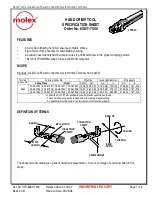
6
Before Operating
1. Inspect the unit for evidence of fluid leaks,
damaged hydraulic fittings, or other damage
such as bent, broken, or missing parts. Fix
or replace as needed before operating.
2. Check the fluid level.
Place the pump unit on a level surface. Use
a flat blade screwdriver to remove the oil-fill
screw and seal from the top of the pump
cylinder (A, Fig. 1).
Fig. 1
If the fluid is below the metal rod inside the
pump, add enough good-quality hydraulic
fluid to just cover the rod. Do not overfill.
Replace the seal and tighten the screw.
Use only good-quality
hydraulic fluid. Improper fluid can cause
premature failure of the jack, and the
potential for sudden and immediate loss of
load. Failure to comply may cause serious
injury!
Fluid Maintenance
On a yearly basis, drain and refill the hydraulic
fluid for optimum performance.
1. To drain, open the release valve. Remove
the screw and seal. Invert the pump and
drain the fluid in to a suitable container. Do
not let dirt get into the system.
2. Refill with good-quality hydraulic fluid.
IMPORTANT!
Dispose of hydraulic fluid in
accordance with local regulations. Avoid mixing
different types of fluid, and NEVER use brake
fluid, transmission fluid, motor oil, or glycerin.
Operation
The pump can be used in a vertical or horizontal
position. Always keep the hose end of the pump
unit facing down when using in the vertical
position.
1. Connect the hydraulic pump hose to the
hydraulic ram. Tighten the connection firmly
prior to pumping.
2. Close release valve (B, Fig. 2) by turning it
clockwise. Do not over tighten.
Fig. 2
3. Pump the handle until the ram reaches the
desired distance or pressure required.
4.
Release the pressure by turning the release
valve counter-clockwise.
Storage
1. Make sure the release valve on the pump
unit is open and the ram is in the retracted
position when not in use.
2. Keep parts and attachments in the case
when not in use.
A
B


































